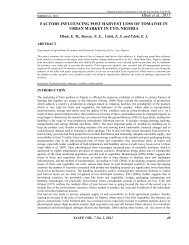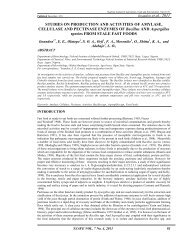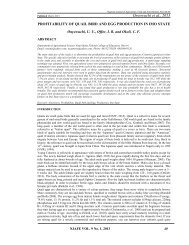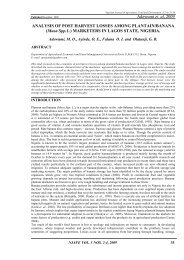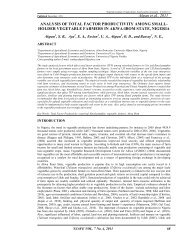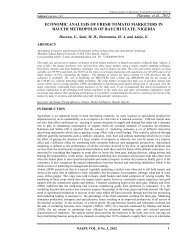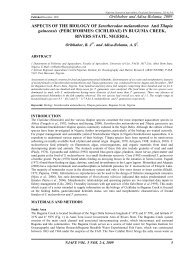Ajayi et al., 2012 - Njafe.org
Ajayi et al., 2012 - Njafe.org
Ajayi et al., 2012 - Njafe.org
You also want an ePaper? Increase the reach of your titles
YUMPU automatically turns print PDFs into web optimized ePapers that Google loves.
Nigerian Journ<strong>al</strong> of Agriculture, Food and Environment. 8(2):9-11<br />
Published June, <strong>2012</strong> <strong>Ajayi</strong> <strong>et</strong> <strong>al</strong>., <strong>2012</strong><br />
ESTABLISHMENT OF PERMANENT SAMPLE PLOTS FOR CONTINUOUS<br />
FOREST INVENTORY IN A TEACHING AND RESEARCH PLANTATION OF<br />
TEAK (Tectona grandis L. f.) IN CROSS RIVER STATE, NIGERIA<br />
ABSTRACT<br />
<strong>Ajayi</strong> 1 , S., Ayambem 1 , W, A., and Etig<strong>al</strong>e 3 , E. B.<br />
1 Department of Forestry and Wildlife Resources Management, Cross River University of Technology, P.M.B 102, Obubra,<br />
Cross River State, Nigeria. Phone +234 (0)8038368014; +234 (0)8059456270<br />
2 Department of Forestry and Wildlife,University of Uyo, Uyo,Akwa –Ibom State, Nigeria<br />
Permanent sample plots were established for Continuous Forest Inventory (CFI). A surveyed map of the Cross River<br />
University of Technology (CRUTECH) Teak (Tectona grandis L.f.) plantation was plotted and grids of 20m x 20m ground<br />
equiv<strong>al</strong>ent were made on the map where four (4) permanent sample plots were chosen randomly. Number of trees enumerated<br />
where 18, 16, 16 and 12 for plot 1, 2, 3 and 4 respectively. Diam<strong>et</strong>ers at breast height (dbh) of trees in the four plots were<br />
measured using the girthing tape. The data obtained were an<strong>al</strong>yzed using the norm<strong>al</strong> probability distribution function, which<br />
showed that 68% of the trees had diam<strong>et</strong>er class range of 15cm and 25cm, 16% has diam<strong>et</strong>er range of 10cm - 15cm, 14% and<br />
2% of the trees ranged from 25cm – 30cm and 30cm – 35cm respectively. The result <strong>al</strong>so showed that the actu<strong>al</strong> stocking of<br />
the plantation was 24.25% which shows a high level of mort<strong>al</strong>ity. There is need for replanting of the plantation to achieve its<br />
management objectives.<br />
Keywords: Permanent plots, forest inventory, teak, research plantation,<br />
INTRODUCTION<br />
Forest resources are renewable natur<strong>al</strong> resources and Nigeria as a nation is abundantly endowed with these<br />
resources (Ijeomah and Aiyeloja 2010). In order to effectively and sustainably manage these forest resources,<br />
there is need for periodic measurement of variables. Data obtained during measurements could be used for<br />
effective planning, policy formulation as well as decision making, for research purposes and monitoring of yield<br />
in the forest plantation and the entire forest ecosystem (Ijeomah and Aiyeloja, 2010). Establishing permanent<br />
sample plots in even and uneven aged stands provides high qu<strong>al</strong>ity and loc<strong>al</strong> data on the growth of forest<br />
plantation (GYHOST/GYH, 2002). The need for proper forest management planning is the ultimate foundation of<br />
effective forest management. It provides the basis for future planning of the plantation and <strong>al</strong>so serves as a<br />
yardstick for monitoring growth performance. Carrying out compl<strong>et</strong>e enumeration in large forest is practic<strong>al</strong>ly<br />
cumbersome and time consuming and <strong>al</strong>so expensive (Ge<strong>org</strong>e, 1992). Information obtained from permanent<br />
sample plots will help in d<strong>et</strong>ermining the rate of growth increment of the plantation over time.<br />
It is imperative to establish permanent sample plots in order to carry out continuous forest inventory (CFI). CFI is<br />
a periodic operation used to provide information on the current state of a plantation in comparison to previous<br />
data (GYHOST/GYH, 2002). The concept of measurement in forestry is an important tool for forest management.<br />
Whereas there have not being established permanent sample plots for continuous forest inventory (CFI) in the<br />
CRUTECH Teaching and Research Teak (Tectona grandis) plantation, this research will go a long way in<br />
highlighting the role of permanent sample plots where loc<strong>al</strong> data could be generated periodic<strong>al</strong>ly for proper<br />
management of the plantation.<br />
The objectives of the study therefore were to establish permanent sample plots for continuous forest inventory<br />
(CFI) of teak plantation and d<strong>et</strong>ermine the stand density and diam<strong>et</strong>er distribution of trees in the plantation.<br />
MATERIALS AND METHODS<br />
Study area<br />
The study was carried out in a fifteen-year-old teaching and research teak (Tectona grandis L.f.) plantation of<br />
CRUTECH Obubra Campus. Obubra lies b<strong>et</strong>ween latitude 6° 05′ and 8° 20′ N and longitude 6° 08′ and 8° 33′ E.<br />
Obubra is in the tropic<strong>al</strong> rainforest and has too distinct seasons the rainy and dry seasons. The rainy season<br />
begins from May through October, while dry season starts from November through April. It has an annu<strong>al</strong> rainf<strong>al</strong>l<br />
of 2000 – 2250mm and relative humidity b<strong>et</strong>ween 60 – 70% (Mfam, 2002).<br />
Sampling techniques<br />
A reconnaissance survey of the plantation was carried out to check for important features in the plantation.<br />
Prismatic compass was used to take coordinates or bearings, cutlass was used to create transect to <strong>al</strong>low for<br />
possible movement while ranging poles were used to <strong>al</strong>ign the bearings. The 30m tape was used in taking ground<br />
measurements. A map was plotted and grids of 20m x 20m ground equiv<strong>al</strong>ent were formed on the map and<br />
NJAFE VOL. 8 No. 2, <strong>2012</strong> 9
Nigerian Journ<strong>al</strong> of Agriculture, Food and Environment. 8(2):9-11<br />
Published June, <strong>2012</strong> <strong>Ajayi</strong> <strong>et</strong> <strong>al</strong>., <strong>2012</strong><br />
numbered (<strong>Ajayi</strong> <strong>et</strong> <strong>al</strong>., 2006). Pieces of papers amounting to the number of grids were numbered. Folded and<br />
four (4) pieces were picked at random to avoid bias. Compl<strong>et</strong>e enumeration of diam<strong>et</strong>er at breast height (DBH)<br />
was done on trees of diam<strong>et</strong>er 10cm and above.<br />
Data collection and an<strong>al</strong>ysis<br />
In each plot, DBH was measured at the point 1.3m above ground level by winding the girthing tape around<br />
individu<strong>al</strong> trees of diam<strong>et</strong>er 10cm and above. Data were an<strong>al</strong>yzed using descriptive statistics to obtain the mean<br />
DBH and standard deviation. The gener<strong>al</strong> mean DBH () and standard deviation () for <strong>al</strong>l trees in the four plots<br />
were fed into the norm<strong>al</strong> probability distribution functions to categorize trees according to diam<strong>et</strong>er classes. The<br />
probability density function is of the form (Gadow, 1983)<br />
1 - ½ ( x – ) 2<br />
f (x) = exp<br />
2 2<br />
where,<br />
= mean<br />
x = random variable and;<br />
2 = variance.<br />
For a norm<strong>al</strong>ly distributed population; it is expected that 68.27% of the cases will f<strong>al</strong>l b<strong>et</strong>ween, - and + <br />
and 95.45% b<strong>et</strong>ween -2 and + 2 while 99.73% of the cases are found b<strong>et</strong>ween - 3 and + 3<br />
(Hamilton, 1988).<br />
RESULTS AND DISCUSSION<br />
Established Permanent Sample Plot: Four sample plots were selected from a sampling frame of 38 plots. Each<br />
plot had an area of 0.04 ha. The numbers of trees enumerated were 18, 16, 16, and 12; mean DBH were 18.4,<br />
20.36, 20.74, 21.04 and standard deviation were 4.38, 4.96, 4.54 and 6.08 for plots 1, 2, 3, and 4 respectively<br />
(Table 1). Clear demarcation of the plots and permanent tagging of the trees in each plot were essenti<strong>al</strong> for the<br />
management of objective of teaching and research. Data generated periodic<strong>al</strong>ly will be used to assess and ev<strong>al</strong>uate<br />
the plantations performances over time.<br />
Table 1: Stand summary of Teak (Tectona grandis) in CRUTECH Teaching and Research plantation<br />
S/N Summary Plot 1 Plot 2 Plot 3 Plot 4 Tot<strong>al</strong> x<br />
1. Plot size (ha) 0.04 0.04 0.04 0.04<br />
2. Number of stem/ plot 18 16 16 12 62 16<br />
3. Mean DBH (cm) 18.40 20.36 20.74 21.09 50.59 20.15<br />
4. Standard deviation (cm) 4.38 4.96 4.54 6.08 19.96 4.99<br />
Stand density<br />
The initi<strong>al</strong> stocking at 2.5m x 2.5m amount to 1600 plants per hectare. The current or actu<strong>al</strong> stocking of 388 trees<br />
per hectare (24.25%) indicated high mort<strong>al</strong>ity rate (75.75%). The high percentage of mort<strong>al</strong>ity observed in the<br />
plantation could be attributed to regular fire outbreak, illeg<strong>al</strong> felling by residents of host communities for<br />
fuelwood, and poor management.<br />
Diam<strong>et</strong>er distribution<br />
The gener<strong>al</strong> mean () was <strong>al</strong>so c<strong>al</strong>culated to be 20.15cm while the standard deviation () was 4.99cm. 388 trees<br />
obtained per hectare had a distribution of 62, 133, 132, 53 and 8 for 10 – 15cm, 15 -20 cm, 20 – 25 cm, 25 -30 cm<br />
and 30 – 35cm DBH classes respectively (Table 2). The trees of diam<strong>et</strong>er 15cm – 20cm and 20 – 25cm<br />
represented about 68% of the tot<strong>al</strong> stock. These trees should be <strong>al</strong>lowed to grow to a more mature diam<strong>et</strong>er of<br />
about 35cm and above before harvesting. While the 14% representing trees of DBH 25cm – 30cm were suitable<br />
for electric poles in the rur<strong>al</strong> communities, 2% of the stock represented trees of DBH 30cm - 35cm and could be<br />
selectively and carefully harvested for timber. Norm<strong>al</strong> probability distribution is an efficient tool for<br />
characterizing trees in forest plantation (Philips, 1994; <strong>Ajayi</strong> <strong>et</strong> <strong>al</strong>., 2007).<br />
NJAFE VOL. 8 No. 2, <strong>2012</strong> 10
Nigerian Journ<strong>al</strong> of Agriculture, Food and Environment. 8(2):9-11<br />
Published June, <strong>2012</strong> <strong>Ajayi</strong> <strong>et</strong> <strong>al</strong>., <strong>2012</strong><br />
Table 2: Norm<strong>al</strong> distribution of diam<strong>et</strong>er at breast height (dbh) for CRUTECH teak (Tectona grandis) Plantation<br />
DBH (cm) Probability Frequency %<br />
10 – 15 0.1599 62 16<br />
15 – 20 0.3437 133 34<br />
20 – 25 0.3402 132 34<br />
25 – 30 0.1358 53 14<br />
30 – 35 0.0204 8 2<br />
Tot<strong>al</strong> 388 100<br />
CONCLUSION AND RECOMMENDATION<br />
The permanent sample plots established were essenti<strong>al</strong> for assessment of planting stock in an even – age forest.<br />
The study reve<strong>al</strong>ed a high rate of mort<strong>al</strong>ity over the years due to human activities in and around the plantation.<br />
This means replanting in the entire plantation is of paramount importance. Large proportion of teak (Tectona<br />
grandis) in the CRUTECH teaching and research plantation f<strong>al</strong>ls under DBH 15cm – 25cm (pole sizes). Intensive<br />
plantation management is necessary to me<strong>et</strong> the management objective of teaching and researching.<br />
REFERENCES<br />
<strong>Ajayi</strong>, S., Olajide, O., Uzowulu, G. I., Ebu, V.T. 2006. Predicting Individu<strong>al</strong> Tree Heights in Gmelina arborea<br />
Plantation of Ukpon River Forest reserve, Cross River State, Nigeria. Journ<strong>al</strong> of Agriculture, Forestry<br />
and the Soci<strong>al</strong> Sciences. 4(2): 107 – 118.<br />
<strong>Ajayi</strong>, S., Osho, J. S. A. and Anyaorah, C. N. 2007. Development and use of Weibull Distribution Model for<br />
Diam<strong>et</strong>er Class D<strong>et</strong>ermination in Gmelina arborea plantation of Ukpon River forest Reserve Cross River<br />
State, Nigeria. Journ<strong>al</strong> of Sustainable Agriculture and the Environment. 9(2):164 – 173.<br />
Avery, I. E. and Burkhart, H. E. 1994. Forest Measurements 4 th Ed. McGraw-Hill Int. New York. 408 pp.<br />
Gadow, K. V. 1983. Fitting distributions in Pinus patula stands. South African Forestry Journ<strong>al</strong>. September 1983<br />
pp 20 – 29.<br />
Ge<strong>org</strong>e, T. 1992. Harvesting Forest Products. Hertford Hertz. England 159p<br />
GYHOST/GYH. 2002. Canadian Forest Inventory. Minutes of the 25 th me<strong>et</strong>ing. Canada<br />
Hamilton, G. J. 1988. Forest mensuration Handbook. Forestry Commission Bookl<strong>et</strong> 39. London 274p.<br />
Ijeomah, H. M. and Aiyeloja, A. A. 2010. Ecotourism: An instrument for combating Renewable natur<strong>al</strong> Resources<br />
Degradation. In: Practic<strong>al</strong> Issues in Forest and wildlife Resources management. Ed. (Ijeoma, H. M and<br />
Aiyeloja). Green canopy consultants, Choba, Porthacourt, Nigeria, 625p.<br />
Mfam, K. 2002. Cross River State. The people paradise. Basic Review and facts. John and Co. Press C<strong>al</strong>abar.<br />
Philip, M. S. 1994. Measuring Trees and Forests. (for African Students) Aberdeen University Press, Aberdeen,<br />
Scotland 338p.<br />
NJAFE VOL. 8 No. 2, <strong>2012</strong> 11




